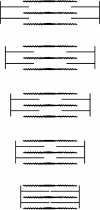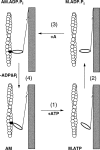The early history of the biochemistry of muscle contraction
- PMID: 15173217
- PMCID: PMC2234565
- DOI: 10.1085/jgp.200409091
The early history of the biochemistry of muscle contraction
Figures





Similar articles
-
Conformational switching in muscle.Adv Exp Med Biol. 2004;547:61-80. doi: 10.1007/978-1-4419-8861-4_6. Adv Exp Med Biol. 2004. PMID: 15230093 Review.
-
Functional classification of skeletal muscle networks. I. Normal physiology.J Appl Physiol (1985). 2012 Dec 15;113(12):1884-901. doi: 10.1152/japplphysiol.01514.2011. Epub 2012 Oct 18. J Appl Physiol (1985). 2012. PMID: 23085959 Free PMC article.
-
Molecules in motion: Michael Sheetz, James Spudich, and Ronald Vale receive the 2012 Albert Lasker Basic Medical Research Award.J Clin Invest. 2012 Oct;122(10):3374-7. doi: 10.1172/jci66361. J Clin Invest. 2012. PMID: 23193575 Free PMC article. No abstract available.
-
Memories of Annemarie Weber.Anat Rec (Hoboken). 2014 Sep;297(9):1543-7. doi: 10.1002/ar.22963. Anat Rec (Hoboken). 2014. PMID: 25125168 Free PMC article. No abstract available.
-
Lifting the nebula: novel insights into skeletal muscle contractility.Physiology (Bethesda). 2010 Oct;25(5):304-10. doi: 10.1152/physiol.00016.2010. Physiology (Bethesda). 2010. PMID: 20940435 Review.
Cited by
-
Protein nanomechanics in biological context.Biophys Rev. 2021 Aug 7;13(4):435-454. doi: 10.1007/s12551-021-00822-9. eCollection 2021 Aug. Biophys Rev. 2021. PMID: 34466164 Free PMC article. Review.
-
Thick Filament Protein Network, Functions, and Disease Association.Compr Physiol. 2018 Mar 13;8(2):631-709. doi: 10.1002/cphy.c170023. Compr Physiol. 2018. PMID: 29687901 Free PMC article. Review.
-
Order-Disorder Transitions in the Cardiac Troponin Complex.J Mol Biol. 2016 Jul 31;428(15):2965-77. doi: 10.1016/j.jmb.2016.06.022. Epub 2016 Jul 6. J Mol Biol. 2016. PMID: 27395017 Free PMC article. Review.
-
Use of Amino Acids as Supplements for Matching Nutrition, Training, and Rehabilitation-Focusing on Some Questions.Nutrients. 2025 Aug 18;17(16):2667. doi: 10.3390/nu17162667. Nutrients. 2025. PMID: 40871694 Free PMC article. Review.
-
Reconstitution of contractile actomyosin rings in vesicles.Nat Commun. 2021 Apr 15;12(1):2254. doi: 10.1038/s41467-021-22422-7. Nat Commun. 2021. PMID: 33859190 Free PMC article.
References
-
- Alberts, B., A. Johnson, J. Lewis, M. Raff, K. Roberts and P. Walter. 2002. Molecular Biology of the Cell. Fourth edition. Garland Publishing. 950 pp.
-
- Asakura, S. 1961. F-actin adenosine triphosphatase activated under sonic vibration. Biochim. Biophys. Acta. 52:65–75. - PubMed
-
- Asakura, S., M. Taniguchi, and F. Oosawa. 1963. Mechano-chemical behaviour of F-actin. J. Mol. Biol. 7:55–69.
-
- Astbury, W.T. 1947. Croonian lecture. On the structure of biological fibers and the problem of muscle. Proc. R. Soc. Lond. B. Biol. Sci. 134:303–328. - PubMed

